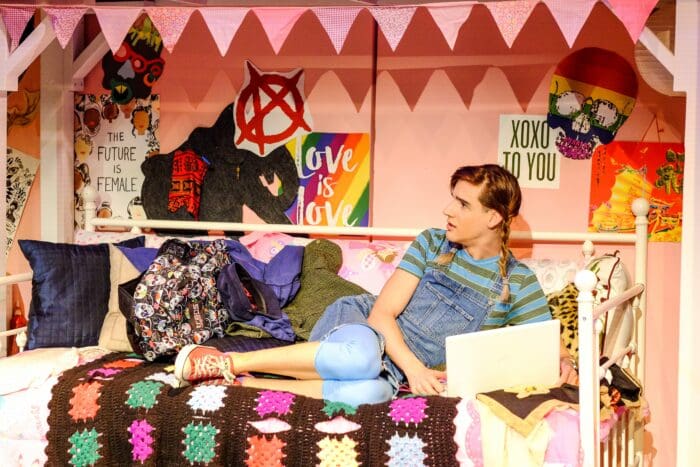
Despite growing connectivity and the ever-expanding access to information, activism has arguably become a largely symbolic, lazy activity devoid of lasting impact. Occupy Wall Street caused a ruckus for a few months and slowly died away, leaving the large financial institutions at the center of the debate untouched. Women marched in pink hats but Donald Trump still sits in office, demeaning women (and many men) on a daily basis. Teenagers marched for greater gun control, yet I can still purchase a semi-automatic weapon online with my Chase Sapphire Preferred Card. Black Lives Matter. Save DACA. Tweet, post, share – pause – repeat. This is the world in which Alexis Roblan’s play Red Emma and the Mad Monk is set – one where any person with computer access is suddenly both an expert and a social crusader on any given issue, only to move on with the change of the news cycle. Red Emma is a clever and funny play, with an overlay of pointed social commentary, that encourages introspection; however, for all its intrigue, Roblan’s play suffers from one distinct flaw: an identity crisis. Neither obviously classified as a musical nor a straight play, Red Emma would be better served if the creators eliminated the musical elements of the show and lengthened the narrative.
Red Emma tells the story of Addison, a prepubescent teen who speaks at length with her imaginary friend, turn of the century Russian mystic Grigori Yefimovich Rasputin. Addison romanticizes Rasputin’s mystical healing abilities, his role within the Russian revolution and his eventual demise following a long, death defying assassination attempt. It is a romantic fantasy that makes Addison’s digital life seem dull and childish – she wages minor skirmishes on Twitter with unseen trolls (and, quite possibly, robots) under a Rasputin avatar, but her impact is minimal. In search of inspiration, and with the help of the internet, Addison’s interest soon shifts to outspoken Russian anarchists Emma Goldman and Sasha Berkman. But, as Addison learns more about Rasputin, Berkman and Goldman, she begins to question the effectiveness of challenging the government, social and political norms and learns some difficult lessons about the power of controlling narrative, the illusive and malleable reality of “truth” and the dangers of seeking information online.
Red Emma does an excellent job of exploring what seems to be a cycle of futility in the efforts of working class and middle class individuals to topple institutions of oppressive power. Short outbursts of energy are expended, resulting in some perceived success (e.g., toppling the Russian Tsar, wounding a vile businessman, scaring an online troll) only to have the narrative shift (and with it, people’s interests and attitudes) such that nothing really changes and the status quo is once again imposed. Roblan’s choice to explore this cycle with Russia at the core of the narrative is both timely and inspired, with Addison realizing that the internet is simply another platform on which powerful people can steer public opinion (and can do so behind the shroud of an avatar). In fact, if it was not for one rather large creative choice, I believe that Red Emma has excellent potential to develop beyond its current form. That creative decision, unfortunately, was the choice to make Red Emma a musical. Or, rather, a play with music as the musical interludes (composed by Teresa Lotz) are not significant enough in number or length to truly label Red Emmaa musical. In general, the musical numbers are far too light in tone to fit within the darkly comedic plot. For example, when revealing Emma Goldman’s polyamorous lifestyle, the accompanying song sounds like a sex-fueled Schoolhouse Rock lesson that comes across as poking fun at Goldman’s relationships – likely not the aim of the writers. This is not to say that there are not musical highlights in the show, but the music did more to pull the audience out of the piece than to add to their experience of it.
Red Emma’s design team does a marvelous job of transforming the space at The Tank into Addison’s fantasy world, grounded by Diggle’s charming and intricately detailed set design. Glenna Ryer’s costume design evokes the spirit of the generational and cultural gaps between the characters, which makes their interactions seem jarring and humorous. The entire ensemble is incredibly strong and talented (including many members who pull off consistent and believable accents, which is no small feat). Highlights in the ensemble include Maybe Burke as the naive but enthusiastic Addison – Burke enlivens the show with youthful exuberance but also aptly conveys Addison’s journey from a sheltered child to a more worldly teen who has begun to recognize the sinister side of the world in which we live. Often Burke’s counterpart on stage, Drita Kabashi is a masterful scene-stealer and comedienne as Rasputin. From Kabashi’s accent to her mannerisms, she has crafted a hilarious yet grounded character who evolves throughout the piece as Rasputin’s creator, Addison, grows in knowledge and experience – Kabashi’s Rasputin is reflective of Addison and Addison’s intellectual and emotional development.
Despite the questionable choice to transform the piece into a musical, Red Emma and the Mad Monk is absolutely worth a visit. Incorporating smartly written humor with contemporary social and political issues, Red Emma is a radically complex and thought-provoking piece that is also incredibly enjoyable.
